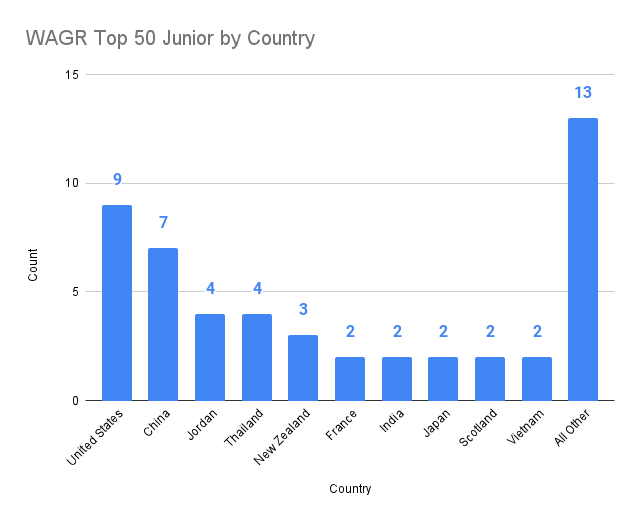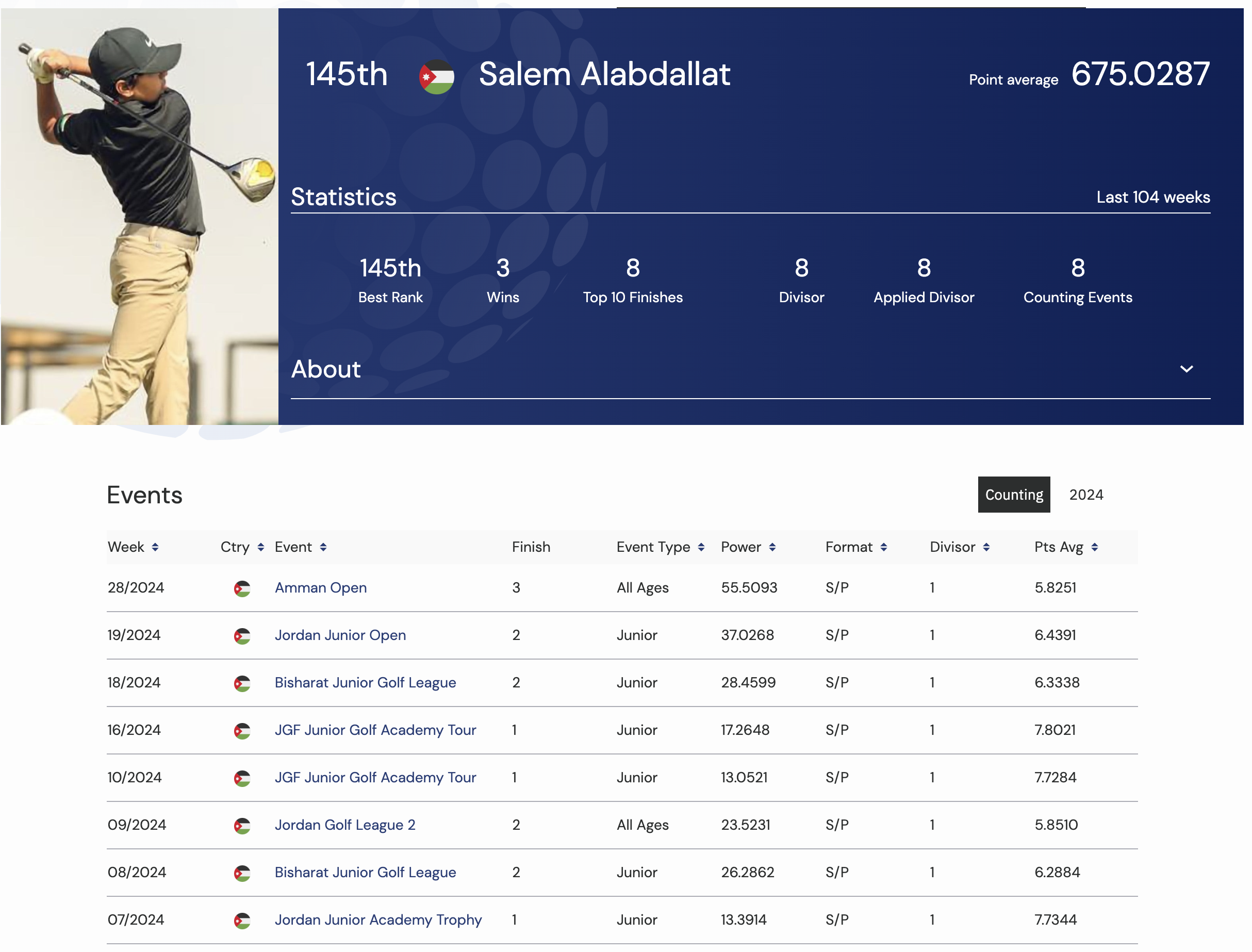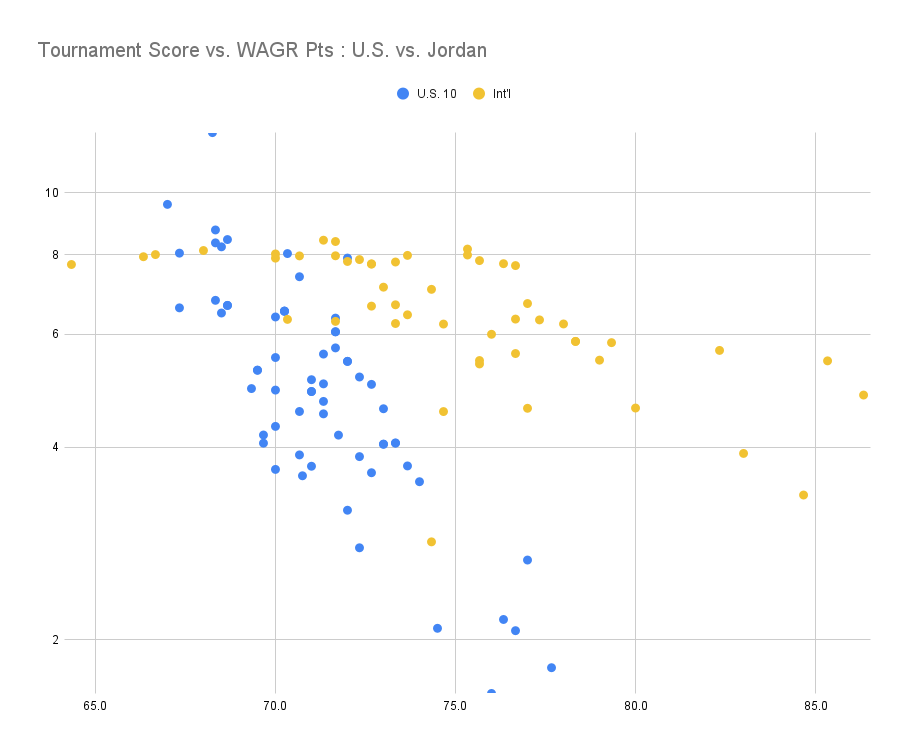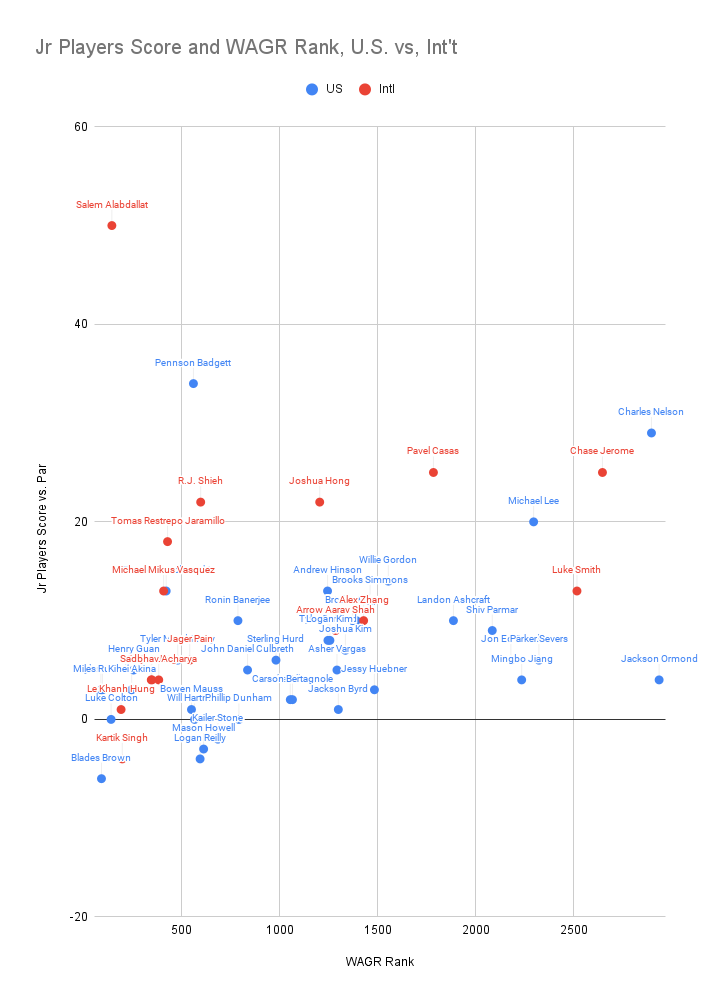Related Content

Inspiring golfers to pursue this great game with drive and passion
Keywords
Related Posts

WAGR Files: WAGR Whac-A-Mole (Part III: U.S. Junior Exemption Impact)
2025 WAGR Changes may impact the exemption status of up to 30 Junior Golfers

WAGR Files: WAGR Whac-A-Mole (Part II: Staying Ranked)
How are the 998 Junior Golfers on WAGR impacted by the 2025 Changes?

WAGR Files: WAGR Whac-A-Mole (Part I: Getting Ranked)
A deep dive of 2025 WAGR changes shows it may have unintended consequences to US Juniors
A quick look at the top 50 juniors in the world according to WAGR reveals an interesting distribution by country.

For context, 27 of the top 50 players overall in the WAGR (most of whom are college players) are from the U.S., and on DataGolf, 22 of the top 50 players are also American. This suggests you might expect a roughly 50/50 split between U.S. and international players. But something else stands out—four of the top 50 juniors are from Jordan. Remarkably, all four Jordanian juniors are ranked 333 or better on the WAGR.

Looking back a year ago, Mousa was ranked 405th on WAGR, while Hashem and Mohammed were just beginning their junior WAGR careers, ranked 2502 and 4456, respectively. Salem Alabdallat, who only became a ranked player in February, has since reeled off an impressive string of top 3 finishes.

Let’s take a closer look at the junior tournaments, scores, and WAGR point allocation for these four Jordanian players in 2024. For comparison, we’ll also examine the tournament scores and WAGR points for the ten U.S.-based junior players ranked immediately behind them: [Josiah Hakala - 390, Trevor Gutschewski - 422, Tyler Mawhinney - 481, CJ Winchenbaugh - 498, Bowen Mauss - 551, Pennson Badgett - 561, Will Hartman - 567, Logan Reilly - 595, Mason Howell - 613, and Michael Riebe - 663]. I’ve plotted the average tournament scores against the WAGR points earned.

The data reveals that in Jordan, it’s possible to shoot 75 or above and still win. Even scores in the 80s aren't penalized as harshly and often earn as many points as when top U.S. juniors shoot around par. In contrast, shooting 75 in a deep U.S. tournament (which can happen to anyone) will likely earn you fewer than 3 points; you essentially have to win something to offset it. In Jordan, however, shooting 75 in a tournament might result in a 2nd or 3rd place finish, still earning 6 or more points. There's even a tournament in the United Arab Emirates where Hashem shot 84-78-85, finished second (out of 9 players), and earned 5.6645 points. This performance was worth more points than J.D. Culbreth received for shooting 69-67-71 and finishing solo 4th at the AJGA Wyndham Invitational.
This disparity raises an important question: how can WAGR fulfill its stated mission to "accurately rank players as they compete in competitions" and "provide a ranking system that enables players to compare with each other even though they may not directly compete against each other in events" when there are such significant differences in outcomes between a country with a deep talent pool like the U.S. and smaller countries like Jordan?
A closer inspection of these junior tournaments in the Middle East shows that they are often run by GEM International and are mixed-gender, likely to gather enough participants to be WAGR-eligible. One particular event, with only six players completing it, was worth more WAGR points than at least FIFTY-SIX AJGA events in 2024.

One thing that was interesting is the four Jordanian juniors almost rarely play against each other. The 52 tournament scores amongst the top four took place over 37 different events, with no more than two in any one event. Contrast that with the top four juniors in the U.S., who have combined to post 48 tournament scores spanning 21 different tournaments, with five tournaments played by all four. Not that I want to give anybody any ideas, but a tournament featuring all four Jordanian players with eight other lesser players would have a Power Rating of 100 and would serve as a near perfect arbitrage opportunity. First place would get 9.27 points (a level consistent with the 19th-ranked player on WAGR), 2nd would get 7.33 (88th), 3rd would get 6.37 (199th) and 4th would get 5.76 (361st). Plus, this tournament would be worth more and more each time you played it, eventually get above 220 Power and leading to each player getting in the top 50 of WAGR (and getting a US Am exemption in additon to the US Junior.)
With this meteoric rise, it will be interesting to track the progress of these junior players from the Middle East, potentially the next hotbed of junior and amateur golf. Mohammad Alrawashdeh was recently named to the International Junior President's Cup team. Mousa Shana'ah earned an exemption into the U.S. Junior and finished 260th (83-84) out of 264 golfers. Salem Alabdallat just shot 90-87-89, finishing last by 16 shots in the Junior Players Championship. Despite these early struggles, we've seen international experience serve as a springboard for future success. For instance, Karthik Singh from India finished 226th in his first U.S. Junior last year, 35th out of 36 golfers earlier this year at the Junior Invitational at Sage Valley, and just finished 3rd at the Junior Players.
Speaking of the Junior Players, here is a plot of WAGR rank and score relative to par for the AJGA Invitational at TPC Sawgrass.

Free E-mail Newsletter
Subscribe to the DRVN Golf Newsletter
DRVN Golf in your inbox, every month